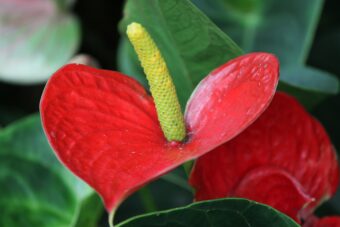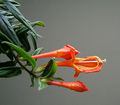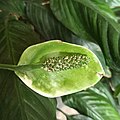In this article, we will be discussing what plants can survive the drying atmosphere of a centrally heated home in winter.
We all know that here in the UK when winter has arrived and it is snowing outside (I know this does not happen often), we all switch on the central heating to feel nice and warm. We may feel warm and comfortable but do our houseplants?

Certain houseplants hate too much heat; they sulk and drop leaves.
They cannot manage without a period of dormancy; the plant will run out of steam. They cannot get used to having warmth during the dormancy period. Are you limited to what houseplants that you can have in your home? The answer is no because you can have plenty of pants around, but they must be temperature controlled, so they will not suffer in the winter’s heat.
The problem is that in general central heated homes the air is dry and this causes some plants to be stressed, especially if you take into account the low lighting levels that enter the home.
Against all these odds, houseplants have to survive, against heat, against the lack of light and the dryness of the air. No wonder houseplants can die in winter.
If your plants start to lose leaves or they start turning yellow, your houseplant is showing stress. The worst thing you can do in winter is to continue to water plants like they need it. Remember that plant is going through a dormancy period and as such do not require much in the way of food or water. All this whilst the houseplant sweat because the central heating is on.
Are they any plants that will not fail even if the central heating is on full blast? The answer is yes and these are the plants that can do so. Remember too much heat is even detrimental to exotic species. So try to keep the heating down, as it not only good for the environment but good for the plants.
ANTHURIUM CRYSTALLINUM (Crystal Anthurium)
This 45 cm tall houseplant has larger, heart-shaped leaves that are purplish whilst young and have a glossy sheen. Any aerial roots that form around the base must be well covered with moist compost as they show.

The plants need good warmth and humidity and in cold locations, leaves will brown around the edges.
They prefer deep shade in summer, moderate light in winter.
An alternative is Anthurium scherzerianum (Flamingo Flower) that has attractive red waxy-textured leaves that appear from spring to autumn. They appear above the spear-shaped leaves on wiry stems, where it grows up to 22.5cm.
Do not plant these houseplants to deep as this will cause the base to rot.
To grow anthurium you need to use a specialised growing media of using fibrous peat, mixed with sphagnum moss and crushed charcoal, along with the normal houseplant compost. Always keep the compost moist but not waterlogged. Mist with tepid water frequently in summer. Make sure that the compost is free-draining.
APHELANDRA SQUARROSA (Zebra Plant)
This easy to look after plant has large spear-shaped, glossy, green leaves that have cream veins. It generally produces yellow flowering spikes and it grows up to 60cm in height.

After flowering, plants can be cut back to keep the plant neat and bushy.
Grow it in a warm location, where the plant will look its best, Best grown in slight shade in summer but in bright, filtered light at other times. When cold, leaves will droop or drop off, but it will recover when it receives the warm the plant likes. Water well in summer, less so in winter. Requires moderate feeding whilst in active growth.
CODIAEUM VARIEGATUM PICTUM (Croton)

This beautiful foliage plant has a variety of different leave shapes and plenty of different colours and markings, where it can reach a height of 60cm. A plant that does not like the cold at all, as its performance will deteriorate. Plant damaged in this way may recover if it is cut back in spring and the cuts dusted with charcoal and its placed in the warmth. New shoots may form or the plant may die.
Grow it in a warm and humid place in bright light but out of direct sunlight. Will be happy in an 18cm diameter pots for some time. The compost must be moist at all times, so water well in summer, much less in winter. Feed moderately in summer if you want your plant to be at their best.
COLUMNEA x BANKSII (Goldfish Plant)
This trailer has dark green, glossy leaves and reddish-orange, tubular flowers from autumn to spring, that are sometimes followed by pale violet berries. This trailer can grow up to 90cm in length so does require space to grow.

An alternative is Columnea gloriosa that has hairy, green leaves and tubular, scarlet flower with yellow throats from autumn to spring. This trailer grows up to 1.2m in length.
Must be grown in a warm position in moderate humidity at all times including winter. Best grown in hanging baskets, where their beauty can be admired.
To grow special potting mix has to be created by mixing 2/3 multipurpose compost with 1/3 by volume of sphagnum moss, with a little crushed charcoal and some slow-release fertiliser. The plant needs to be moist at all times, but not waterlogged, Regularly misting is required to keep humidity high.
DIEFFENBACHIA MACULATA (Dumb Cane)

This popular foliage plant comes in many variable forms and size, but what they have in common is the leaves are colourful and variegated. Many heights do the plant come in from true dwarves to 30cm plus plants.
Grow it in good warmth and light in winter but light shade in summer. It needs high humidity to do well. Not an easy plant to look after, as it has many demanding requirements. Besides it needs for high humidity, its roots do not like to be waterlogged, so do be careful when you water around the stem base. Water well in summer and less so in winter.
DIZYGOTHECA ELEGANTISSIMA (Spider Plant)
This familiar houseplant has wiry stems that have reddish to light cream long, slender-fingered leaves of graceful appearance. They can grow up to 1.5m in height. The great thing about this plant is that it will not grow vigorously unless you keep the temperature and humidity high.

In cold areas, leaves may fall, but soon recover should the plant be placed in warmth once more, where new shoots shall appear. Plants that have grown too tall can also be cut back to keep it in check.
Grow it in a warm and highly humid area in a good light in winter, but in slight shade in summer. Will grow to giant proportions if given a large enough container. Water generously in summer, less so in winter. Frequent misting is ls required during summer to give the best show.
DIPLADENIA SPLENDENS (Pink Allamande)

This is a 4.5m, vigorous climber with luxurious, spear-shaped leaves and produces rose-pink, petunia-like flowers that appear from summer to autumn.
If you wish to keep the plant to more manageable levels, you need to cut back after flowering. Grow it in an 18cm diameter container in a warm and bright location, out of direct sunlight. Does not like chilly or draughty places, so do keep it out of these.
Water generously in summer, whilst misting regularly; sparingly in winter.
PELLIONIA REPENS (Water Melon Begonia)
This is a trailer that grows up to 30cm in height. It has spear-shaped, wavy-edged green leaves that are patterned with light and dark green markings and suffused with bronze tints.

The leaves are also pink to purple underneath. A very decorative plant whilst young, but older plants tend to become leggy at the centre. This needs to be cut back but will take a while to regenerate its decorative appearance.
Grow it in a warm and moderate humidity room and is a great subject in terrariums or other glass cases. Does not like erratic temperatures. Water freely all year round, including winter. Feed throughout the growing season with a balanced liquid fertilizer.
PIPER ORNATUM
A beautiful climber that has spear-shaped leaves that are intricately patterned and have green, cream and pink markings. The leaves tend to be reddish underneath, whilst young leaves are entirely red underneath. A plant that can grow up to 90cm or more.

As it is a climbing plant, it is best to train up a moss stick, where a foliar feed can be applied to the moss to feed the plant.
To do well, it needs steady high heat and humidity to success. To get the best leaf colours, you need good light, but no direct sunlight. Like a lot of plants in this list, it does not like drastic temperature changes.
Likes the compost to be moist at all times and frequent misting to keep the leaves from going brown.
REINWARDTIA TRIGYNA (Yellow Flax Plant)
A 60cm tall plant that has a shrubby habit with spear-shaped green leaves and bright yellow primrose-like flowers that are produced all winter. Although it can reach these heights, you can be kept in quite a small pot of 13cm in diameter for a long time.

The biggest problem is that old plants may not flower well and it must be frequently replaced with cuttings taken in spring. To make sure the plant flower well, stand in a sunny position in summer. To keep the plant healthy, place the pots on moist gravel trays and mist frequently when the sun is not shining. One plant that has to be kept moist at all times. After flowering, prune back to maintain a compact habit.
Grow it in an airy but not cool room. In winter keep it in good light or it will fail to flower. Feed during the summer months or come winter again you will have no flowers.
SAINTPAULIA IONANTHA (African Violet)
This 10cm tall favourite houseplant has neat, velvety leaves that are sometimes variegated. If an African violet is looked after right, single to double flowers appear all year round and they come in shades of blue, purple, red or white.

Grow it in steady warmth and humidity in good light but away from direct sunlight. Does not like any chill, draughts, temperature fluctuations and any dry heat (so use bowls of water near radiators to increase humidity).
Thin old plant by removing side crown and suckers, as this can interfere with the flowering by using fine-tipped scissors. Special African violet feed should be used to fertilise these beauties.
Water freely in summer, sparingly in winter. Do not water over the leaves, as this is asking for trouble. Any water droplets on leaves may cause spotting and brown patches in direct sunlight. It is best watered by standing pots in a saucer of water until the plant has drunk enough, then removing them and emptying the saucer. A difficult plant to keep happy at all times.
SPATHIPHYLLUM WALLISII (Peace Lily)
This houseplant has shiny spear-shaped green leaves that are slightly corrugated in a herringbone pattern and borne on long stems. From May to August, white flowers that look like flat arum lilies appear. The plant can grow up to 30cm high.

Grow it in warm and humid conditions in slight shade. Does not like chill or draughts or wide temperature fluctuations. In winter, move the plant to brighter light.
Best grown in a peat-based compost that is mixed with sphagnum moss and crushed charcoal added to prevent the compost from souring. Any repotting should be done in spring. A plant the needs the compost to be moist at all times, whilst misting frequently in summer. A plant that does not need much fertilising, but an occasional feed during the growing season will do it good.
STEPHANOTIS FLORIBUNDA (Madagascar Jasmine)
This is a beautiful climber that is often bought trained around a hoop. A tall climber that can grow up to 3m tall, where the glossy, evergreen, spear-shaped leaves are covered with clusters of waxy, white, intensively fragrant flowers that appear from May to October.

It can survive cold conditions if the compost it grows in is kept on the dryish side. Leaves will be lost but the plant will soon recover once the warmth is returned and water is once more given.
Prefers to be grown in warm temperatures in moderate humidity in summer and will still do well in warm temperatures in winter. Grow up stout support, where growth can be kept in check by pruning after flowering. Feed moderately whilst the flowering buds appear. Water generously in summer and sparingly in winter.
CONCLUSIONS
In this article, we have discussed what plants can survive winter heat provided by central heating. As you can see many plants can take the heat, but not necessarily the dry air, so it is a good idea to humidify the air to aid these houseplants.
A lot of houseplants can survive winter extremes but many do not do well if the plant is suffocating in the heat, but those mentioned in this article will do well in warm conditions with less chance of the plant dying, as long as you follow what is recommended for each plant.
Are you willing to take the chance? If you have any comments or questions on this subject, please do so in the comment box below.
Please keep warm but do not suffocate your houseplants.

This is good advice for me because I never normally make any adjustments to the nurturing of my houseplants during winter. I appreciate all these tips but moreso: the first signs of stress, not planting anthuriums too deep, keeping the crotons out of direct sunlight, and the care of African violets. It only goes to show me that every plant is a science unto itself and I need to know the specific way to grow each plant so that they remain healthy. Thank you
Hi JJ
That is the rules with plants as individual plant have their own requirements. You can give general advice but the trouble with that is that it will not work for all plants. I am trying to help those who struggle to have plants survive central heating homes. I hope you apply this to your own home.
Thanks
Antonio
Thank you for sharing the beautiful review about the colorful and gorgeous flowers. I love flowers and maintain my backyard during the summer with the help of the rest of my family. During winter time I find it very challenging to keep even one plant alive. Even though they may be alive but they are all hidden under the snow.
Your review gave me some more ideas for my home garden. I am glad that I came across your review.
All the best!
Hi Meenaf
Thank you for stopping by and commenting and I do hope you enjoyed reading the article. I am glad I have helped you come up with great ideals to what plants you can use in the home. It is often a difficult decision but I hope it helps you.
Thanks
Antonio